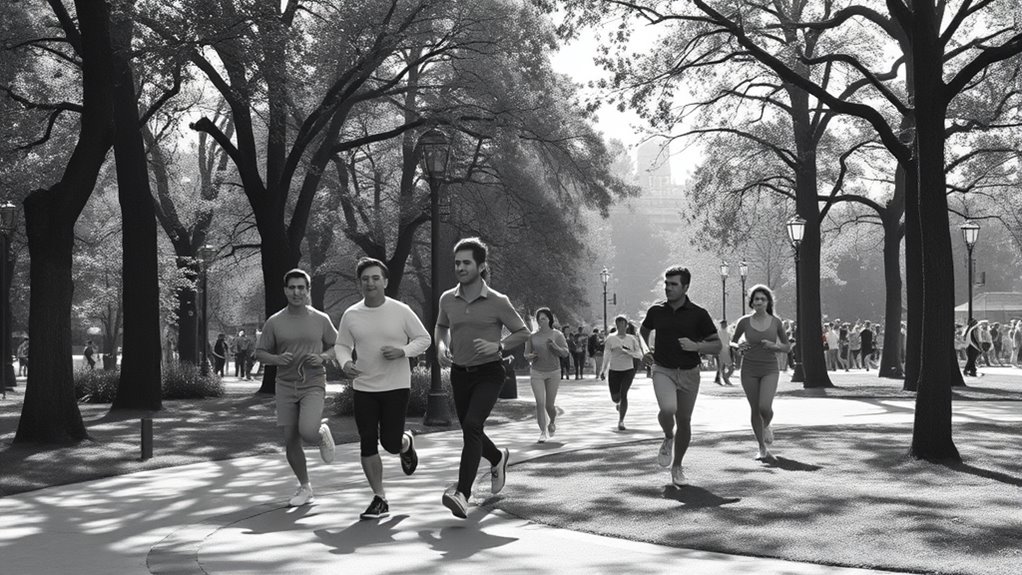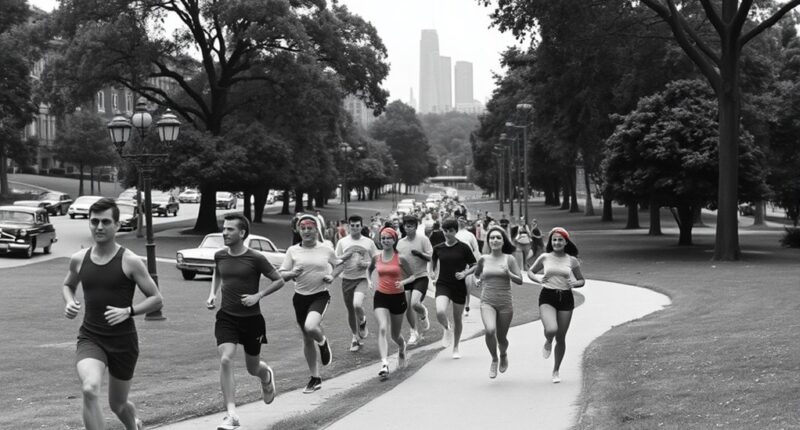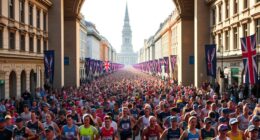In the 1960s, jogging became popular as a simple, accessible way to boost health and fitness. People started embracing it as an alternative to gyms and organized sports, promoting personal empowerment and self-motivation. The activity challenged traditional exercise ideas and encouraged independence, while also inspiring new athletic fashion. This movement fostered a community of runners and influenced broader attitudes toward wellness. If you want to know more about how this fitness trend grew, keep exploring the story behind jogging’s rise.
Key Takeaways
- The 1960s saw jogging shift from a niche activity to a mainstream fitness trend amid growing health awareness.
- Increased accessibility and simplicity made jogging an inclusive alternative to gyms and organized sports.
- Cultural shifts promoted personal empowerment, independence, and self-motivation through outdoor exercise.
- Public health campaigns and community races fostered social engagement and normalized regular jogging.
- The movement influenced fashion and attitudes toward wellness, embedding jogging into everyday lifestyle and culture.

In the 1960s, jogging shifted from a niche activity to a widespread fitness trend, capturing the interest of people across the United States. This movement didn’t happen by accident; it was fueled by a growing awareness of health benefits and a desire for a simple, accessible way to improve personal fitness. Before this era, exercise was often limited to gym workouts or organized sports, but jogging offered a flexible alternative that anyone could adopt. As you lace up your shoes and hit the pavement, you’re participating in a cultural shift that made fitness more inclusive and approachable. The health benefits of jogging, including improved cardiovascular health, weight management, and mental well-being, caught the public’s attention. People began realizing that regular running could help prevent chronic diseases and boost overall vitality, making it an attractive activity for a wide audience. Additionally, the development of the refrigeration cycle played a role in improving the quality and safety of perishable foods, which supported healthier lifestyles during the era.
Jogging in the 1960s became an inclusive fitness movement promoting health and empowerment for all.
The cultural impact of jogging in the 1960s was just as significant as its health benefits. It challenged traditional notions of exercise, which often involved formal gym routines or team sports, and instead promoted independence and self-motivation. Jogging became a symbol of personal empowerment, encouraging individuals to take control of their health outside structured settings. This shift resonated especially with the rising youth movement and the growing focus on individualism during the decade. The image of runners in comfortable attire, often in urban or suburban neighborhoods, helped normalize exercise as a daily routine rather than an activity reserved for athletes or the elite.
You may not realize it, but the cultural impact of jogging extended beyond fitness circles. It influenced fashion, with the emergence of athletic wear designed specifically for running, and it even inspired a new social attitude toward wellness. As jogging gained popularity, it became intertwined with broader cultural themes of self-improvement and personal responsibility. The movement influenced public health campaigns and helped foster a sense of community among runners, whether through local races or informal groups.
In essence, the 1960s saw jogging evolve into more than just a way to stay fit. It became a cultural phenomenon that reshaped how people viewed health, exercise, and their own bodies. By embracing this simple activity, you’re part of a legacy that continues to influence fitness culture today, emphasizing that health benefits and cultural impact can go hand-in-hand in creating a movement that empowers individuals and communities alike.
Frequently Asked Questions
Who Were the Key Figures Promoting Jogging During the 1960S?
You should know that running pioneers like Bill Bowerman and Jim Fixx led the charge during the 1960s. These fitness advocates promoted jogging as a way to improve health and boost fitness. They inspired many to lace up their shoes and hit the streets. Their efforts helped make jogging a popular activity, transforming it from a niche hobby into a mainstream fitness trend that persists today.
How Did Urban Design Influence Jogging Popularity in the 1960S?
Imagine urban planning transforming your city into a jogging paradise overnight! In the 1960s, cities redesigned streets and expanded public parks, making jogging easier and more appealing. Wider sidewalks, dedicated running paths, and lush parks turned ordinary neighborhoods into outdoor gyms. You could now run safely and comfortably, fueling the jogging boom. Urban design didn’t just influence jogging; it made it an unstoppable movement sweeping across communities!
Were There Any Health Concerns Associated With Jogging at That Time?
You might be concerned about health risks and medical concerns related to jogging in the 1960s. Back then, some experts warned about joint injuries, overexertion, and the potential for heart strain. While jogging was gaining popularity, people questioned whether it was safe for everyone, especially those with existing health issues. Despite these concerns, many enthusiasts believed the physical and mental benefits outweighed the risks, encouraging widespread adoption.
How Did Jogging Impact Social Attitudes Towards Fitness?
You see, jogging sparked changing perceptions about fitness, transforming it from a niche activity into a mainstream lifestyle. It fueled the fitness revolution by making regular exercise accessible and appealing to everyone. As more people embraced jogging, societal attitudes shifted to view physical activity as essential for health and well-being. This shift encouraged a more active culture, breaking down previous stigmas and inspiring millions to prioritize their fitness.
What Were the Main Challenges Faced by Early Joggers in the 1960S?
You faced hurdles like social stigma, as jogging was seen as unusual or even risky. Without proper gear, like running shoes, you struggled with comfort and injuries. Many saw jogging as a male-only activity, adding to your isolation. Despite these challenges, you persisted, helping to reshape attitudes toward fitness and making jogging a mainstream part of life. Your perseverance broke barriers, turning a taboo into a health revolution.
Conclusion
As you lace up and hit the pavement, you’re part of a movement that transformed fitness forever. Jogging swept through the 1960s like a wildfire, turning ordinary people into health-conscious explorers. Your simple stride now carries the legacy of pioneers who believed in the power of movement. Remember, your daily jog isn’t just exercise — it’s a revolution that changed the world’s approach to health, making it as unstoppable as a tidal wave.









